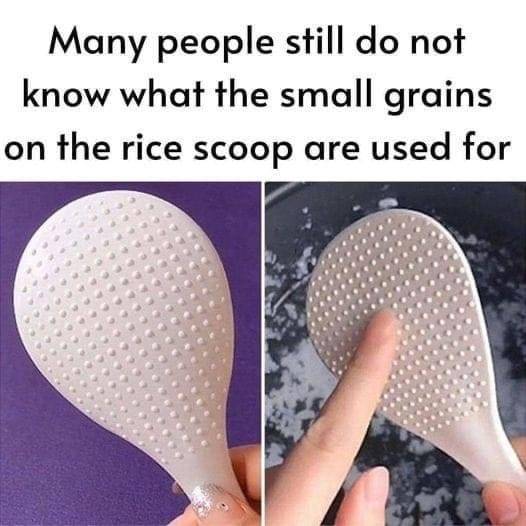If you’ve ever bought a rice cooker, you might have found an unexpected item inside the box—a rice paddle. This tool, which resembles a broad, flat spatula with a rounded head and a short handle, is usually made from plastic or wood. In Japan, it’s known as a “shamoji” and is considered an essential kitchen utensil. Instead of tossing it into a drawer with other infrequently used spatulas, keep it with your rice cooker. Doing so will help maintain the cooker’s condition and enhance the texture of your rice.
Rice Paddle: More Than Just a Spatula

Rice cookers typically have a nonstick interior, which means only specific utensils—like those made from plastic or wood—should be used with them. Using metal or other hard materials can damage the nonstick surface, causing it to peel and lose effectiveness. That’s why most rice cookers include a specially designed rice paddle that’s safe for the coating.
This paddle is designed for stirring, scooping, and serving rice without crushing the grains. After the cooking cycle ends, giving the rice a gentle stir helps release any remaining moisture and ensures an even texture throughout. The rice paddle is perfect for this task, preserving the rice’s fluffiness. It’s also particularly useful when mixing in vinegar for sushi rice preparation.
Do You Really Need a Rice Cooker?
Aside from the included rice paddle, rice cookers can be a real game-changer—especially for those who cook rice often or aren’t fully confident making it on the stovetop. The process is straightforward: the inner pot heats the water to a boil, then automatically reduces the heat or shuts off once the rice is done. Most rice cookers come with clear guidelines on how much water to use for different types and amounts of rice, making the entire process nearly foolproof.
“I love a rice cooker because it removes all the guesswork from cooking rice,” said Dale Talde, chef and owner of Goosefeather. “It’s an essential appliance—because even if you use too much or too little water, it self-adjusts to still deliver perfectly cooked rice.”
Rice cookers aren’t just for rice—they can also be used to prepare curries, stews, and other one-pot meals. In fact, some models include dedicated settings specifically for these dishes. Many also feature quick-cook and delay start functions, giving you the flexibility to prepare meals on short notice or schedule them ahead of time for added convenience.
Rinsing Is a Must
One of the key steps to making great rice is rinsing the uncooked grains thoroughly until the water runs clear. This not only removes surface starch—helping prevent sticky or gummy textures—but also reduces traces of arsenic and clears away dust, dirt, and leftover bran. “I’ve seen how rice is harvested in the fields and processed in factories,” says Min Kim Bryant, a market analyst at Consumer Reports. “It’s the same reason I wash fruits and vegetables—I wash my rice too.” For thicker or more fibrous varieties like wild rice, sushi rice, or brown rice, many experts also suggest soaking them for about 30 minutes before cooking to help soften the grains and improve the final texture.
Mastering Rice on the Stove
Whether or not you own a rice cooker, knowing how to cook rice on the stove is a valuable skill. Begin by selecting a large pot. “Many people use tiny pots and then wonder why the bottom burns while the top stays undercooked,” explains JJ Johnson, chef and owner of Fieldtrip, a rice-focused restaurant in New York. “That happens because the rice doesn’t have enough room to expand.”
When cooking on the stove, precise measurements are key, unlike with rice cookers. Use these water-to-rice ratios for best results:
- 1½ cups of water per 1 cup of long-grain white rice
- 1¼ cups of water per 1 cup of sushi rice
- 2¼ cups of water per 1 cup of short-grain brown rice
Start by bringing the rice and water to a boil over high heat. Then reduce the heat, cover the pot, and let it simmer until all the water is absorbed. Set a timer for about 20 minutes for white rice, and 45 minutes for brown rice. Once done, remove the pot from heat and let it rest, covered, for 10 minutes. Finally, fluff the rice gently—preferably using a rice paddle if you have one.
Extra Rice Cooking Advice
For an extra burst of flavor, try cooking your rice in broth or a combination of water and coconut milk. You can also enhance the aroma by adding spices like saffron or turmeric directly to the pot.
Remember not to stir the rice while it’s cooking, as this can make the grains sticky and mushy. To keep grains from clumping together when cooking on the stovetop, add a small splash of oil.
If you want to change things up, try toasting freshly cooked stovetop rice by heating a little oil in a pan and sautéing the rice for a few minutes—this adds a delightful nutty flavor and texture.
To save time, cook a large batch of rice, divide it into meal-sized portions, and freeze them for later use. When reheating, add a tablespoon of water and microwave or warm it gently in a saucepan with a splash of water or oil to restore moisture.
Lastly, don’t toss leftover rice! Use day-old rice for making rice pudding, thickening soups or stews, or whipping up fried rice dishes.


